|
  This species forms a
large size (22 inches high by 50 inches wide) mound with shiny, dark green, heart
shaped foliage. The medium purple, bell-shaped flowers with purple anthers are borne in July. The flower
scapes may have faint red on them and bear a single bract about half way up. This species forms a
large size (22 inches high by 50 inches wide) mound with shiny, dark green, heart
shaped foliage. The medium purple, bell-shaped flowers with purple anthers are borne in July. The flower
scapes may have faint red on them and bear a single bract about half way up.
Seeds were sent to George Hibbert of Clapham, England in
1790. At the time, it was known as Hemerocallis
coerulea.
According to
The Hostapedia by Mark Zilis (2009), this is "...one of the three
hosta species known to
be native to China (H. plantaginea and
H. 'Lancifolia'
being the others)..."
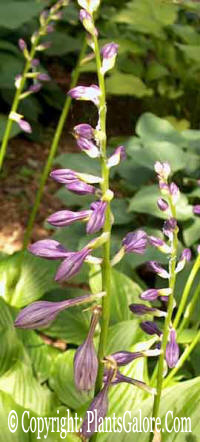 In terms of propagation of this
plant,
Mark Zilis (2000) continues on page 495, "One unusual characteristic of
H. ventricosa
is the formation of asexual (apomictic) seedlings.
The flowers need to be fertilized for seed formation to occur,
but instead of just developing a single, sexually produced
embryo like all other hostas, multiple embryos, asexual in
nature, develop out of endosperm tissue in the seed..." In terms of propagation of this
plant,
Mark Zilis (2000) continues on page 495, "One unusual characteristic of
H. ventricosa
is the formation of asexual (apomictic) seedlings.
The flowers need to be fertilized for seed formation to occur,
but instead of just developing a single, sexually produced
embryo like all other hostas, multiple embryos, asexual in
nature, develop out of endosperm tissue in the seed..."
"...The asexual seedlings are
genetically identical to the mother plant, meaning that H. ventricosa can be clonally propagated by seed with the caveat
that an occasional seedling (from the sexually produced embryo)
will be different."
The New Encyclopedia of Hostas by
Diana
Grenfell (2009) states: "A naturally occurring tetraploid. The only hosta
known to come true from seed. Seeds are produced without fertilization by a
process known as apomixis. Can be used in breeding as a pollen plant, however,
and is the parent of many piecrust-leaved introductions. The very thin leaves
can scorch at the edges in warmer climates, even if grown in full shade. Flowers
do not begin to open until the scape is fully extended."
This cultivar has been awarded
the Royal Horticultural Society's Award of Garden Merit in the
UK.
Mark Zilis (2009)
says, "H. 'Borsch 3' or
H. 'Borsch #3' = H. ventricosa". Also, this plant may
have been sold at one time as Mackwoods No. 7.
Mikiko Lockwood in an article on The Hosta Library titled,
A Little About Japanese Hosta Terms defines the term murasaki as purple.

 An article about H. ventricosa 'Aureo-maculata' and 'Aureo-marginata' by W. George Schmid in
The
Hosta Journal (1985 Vol. 16) states that, "H. ventricosa is one of the oldest hostas in cultivation...The variegated form of
H.
ventricosa that is now identified with the cultivar name of 'Aureo-marculata'
can be traced back to
P.F. von Siebold's time. In 1876, E. Regel published a
paper on hostas in Germany and in it referred to a "Funkia ovata
aureovariegata."...as a possible synonym for 'Aureo-maculata' form." An article about H. ventricosa 'Aureo-maculata' and 'Aureo-marginata' by W. George Schmid in
The
Hosta Journal (1985 Vol. 16) states that, "H. ventricosa is one of the oldest hostas in cultivation...The variegated form of
H.
ventricosa that is now identified with the cultivar name of 'Aureo-marculata'
can be traced back to
P.F. von Siebold's time. In 1876, E. Regel published a
paper on hostas in Germany and in it referred to a "Funkia ovata
aureovariegata."...as a possible synonym for 'Aureo-maculata' form."
Note: Nomenclature changes recommended in the
1991 book The
Genus Hosta by
W. George Schmid and accepted by The American Hosta Society would update names as follows: H. ventricosa 'Aureomaculata'
and H. ventricosa 'Aureomarginata'.
 W. George Schmid in
The
Hosta Journal (1985 Vol. 16) continues, "In 1969, when
I first started hybridizing experiments with
H. ventricosa I concentrated on
this species, because it was very fertile and always gave a good crop of
seedlings. Yet, all I ever got was more H. ventricosa ...a plant showing
pseudogamous apomixis....apomixis means modification of the normal
sexual process...pseudogamy (from the Greek "pseudo" = false, and "gamy"
= sexual union)...It really is vegetative propagation by way of seeds and means
that this hosta cannot produce a cross as a pod parent...H. ventricosa as
a pollen parent will produce hybrids." W. George Schmid in
The
Hosta Journal (1985 Vol. 16) continues, "In 1969, when
I first started hybridizing experiments with
H. ventricosa I concentrated on
this species, because it was very fertile and always gave a good crop of
seedlings. Yet, all I ever got was more H. ventricosa ...a plant showing
pseudogamous apomixis....apomixis means modification of the normal
sexual process...pseudogamy (from the Greek "pseudo" = false, and "gamy"
= sexual union)...It really is vegetative propagation by way of seeds and means
that this hosta cannot produce a cross as a pod parent...H. ventricosa as
a pollen parent will produce hybrids." An article in
The Hosta Journal (1995 Vol. 26 No. 1) citing Vol. 1, #2, Fall 1993,
of the Great Lakes Region Newsletter included a list of Hostas for The Hybridizer from
Jim Dishon:
 Talking about hybridizing in
The
Hosta Journal (1996 Vol. 27 No. 1),
Tony Avent gives the
following comments on cultivars he has introduced: "H. 'Waving Wuffles' -
seedling of H. ventricosa with much narrower leaves and incredible
ruffling...the clump gets much better with age!" Talking about hybridizing in
The
Hosta Journal (1996 Vol. 27 No. 1),
Tony Avent gives the
following comments on cultivars he has introduced: "H. 'Waving Wuffles' -
seedling of H. ventricosa with much narrower leaves and incredible
ruffling...the clump gets much better with age!"
Steve Chamberlain in
The
Hostta Journal (2014 Vol. 45 No. 2) states that, "Of
the species in genus Hosta, there is only one natural tetraploid --
H. ventricosa. This species and its garden sports...are good garden plants with
large flowers and seed pods. The species comes true from seed, although its
pollen has been used to produce hybrids. It is likely that H. ventricosa
embodies one of the benefits of being tetraploid -- the substitution of asexual
for sexual reproduction."


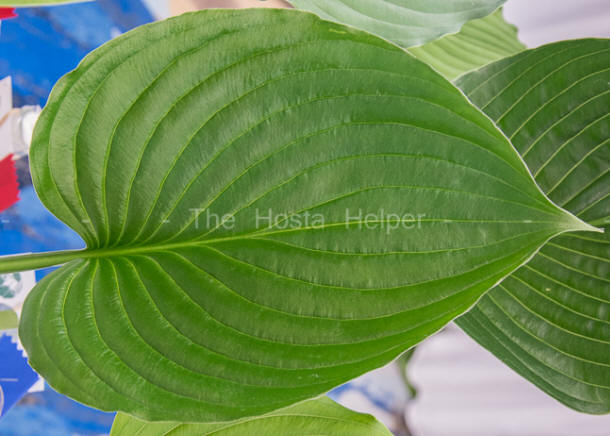


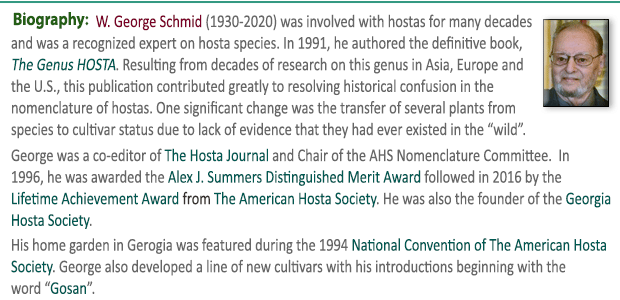
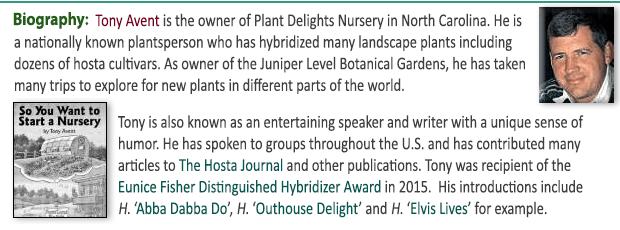
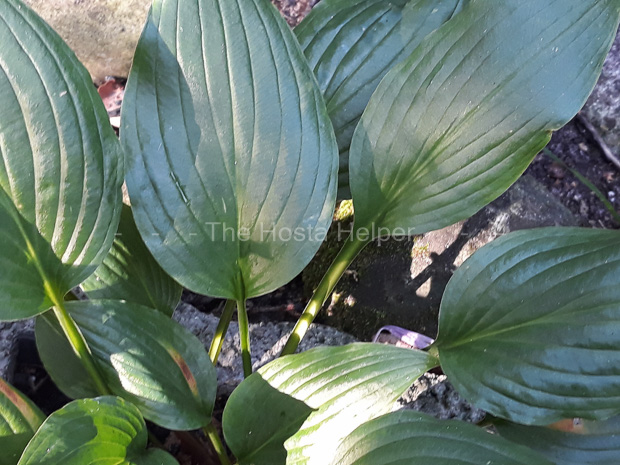

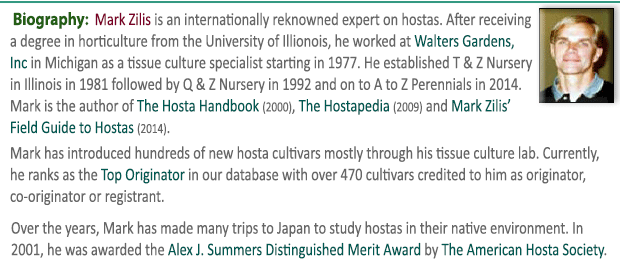



 |



